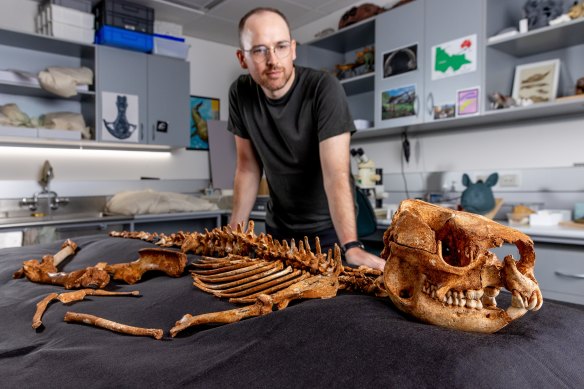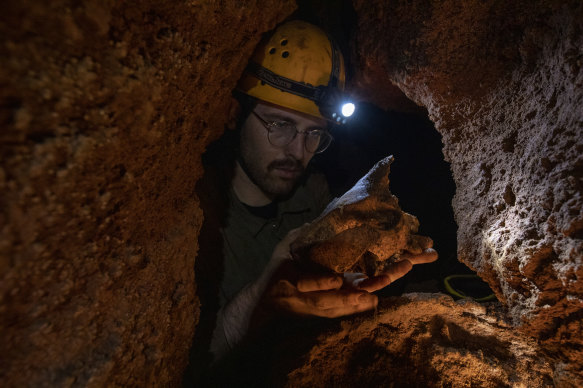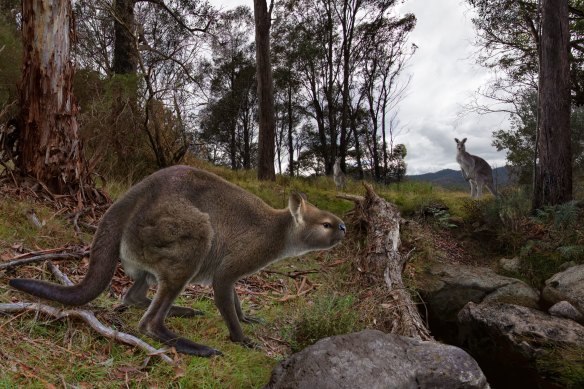In an undiscovered cave, Josh came face-to-face with a human-sized skull
By Angus Dalton
In 2011, recreational caver Joshua van Dyk squeezed into a tiny gap in the ground barely bigger than a wombat hole in Victoria’s east Gippsland, entering an unexplored labyrinth that would come to be named Nightshade Cave.
Spelunking through shafts choked with broken-up boulders and contorting under glittering stalactites that stabbed at his shoulder blades, van Dyk peered into the darkness and met the gaze of a human-sized skull.

Paleontologist Tim Ziegler with an ancient short-faced kangaroo fossil discovered by a recreational caver.Credit: MUSEUMS VICTORIA/TIM CARRAFA
“It was about three-quarters of the way up what you call a pitch [a vertical shaft],” van Dyk recalled. “When I first saw it, the skull was looking at me.”
He didn’t know it then, but the skull belonged to a 50,000-year-old marsupial creature that had left behind one of the most complete fossil skeletons ever discovered in Australia.
Van Dyk snapped photos and eventually recovered the creature’s jawbone for Museums Victoria. The museum deduced it belonged to Simosthenurus occidentalis, a prehistoric, heavyset kangaroo that walked, rather than hopped, through dense Pleistocene-epoch forests. The fossil’s unworn teeth and unfused bones suggested it was an 80-kilogram juvenile.
“This poor little creature has tumbled down into this cave in a pitfall, to a height where it was not able to escape again,” Museums Victoria Research Institute palaeontologist Tim Ziegler said.

Paleontologist Tim Ziegler recovering the ancient short-faced kangaroo skeleton from NIghtshade Cave during a 60-hour mission.Credit: Robert French
Most fossils from the time are recovered from ancient billabongs or river beds and are often incomplete, scattered by the movement of water. “Caves are a different story altogether,” Ziegler said. “They’re like a time machine.”
Protected from water, air currents, and the gnawing teeth of scavengers, 71 per cent of the creature’s skeleton was preserved in remarkable condition.
In a discipline where a smattering of teeth the size of rice grains can upend entire evolutionary theories, it’s a massive find.
“I can’t express to you how profound it is to look in the eye of this skull, and to realise the span of time that it’s been in that place, unchanged,” Ziegler said. “It’s like looking at a mountain and wondering how long it’s been there.
“If the mountain had the consistency of wet tissue paper – that’s how fragile it is.”

An artist’s recreation of S. occidentalis, the short-faced kangaroo that walked, rather than hopped, through forests 50,000 years ago.Credit: Museums Victoria/Peter Trusler
When the skull betrayed signs of accelerated decay in 2021, Museums Victoria and the Victorian Speleological Association swung into action.
Armed with arborists’ ropes, tissues, packing tape and a $16 trowel-like cornice tool from Bunnings, Ziegler and his collaborators embarked on a 60-hour recovery mission. It was so cramped in the cave that at some points Ziegler couldn’t excavate and look at what he was doing at the same time.
“I was often upside down, in the dark with a headlight on, trying to do the paleontological equivalent of open-heart surgery,” he said.
Climbing back through the cave with a backpack full of tissue-cushioned bones, he said, felt like going abseiling with a newborn baby.
Now at Museums Victoria – and set for display in June – the 150-bone fossil is the subject of international research. Simosthenurus lived across the continent for 600,000 years but this specimen was one of the last of its kind. It was born and died in the final 5000 years of its species’ existence.
The giant marsupial lived at the same time as humans at a time when 85 per cent of large Australian animals went extinct.
“It’s a great to-be-solved question of Pleistocene vertebrate palaeontology. It’s a great unsolved question of the Australian landscape. Why did 85 per cent of our megafauna go extinct in a few thousand years at this time?”
The area around Buchan, in east Gippsland, is riddled with caves that have yielded at least 4000 fossils, including those of the one-tonne Palorchestes azael (resembling a marsupial tapir) and the cheetah-sized predator Thylacoleo carnifex.
“All signs point toward the Buchan caves area in East Gippsland as having serious untapped scientific potential to help us understand more about south-eastern Australia’s fossil record, and the ecosystems that have operated here through deep time.”
The Examine newsletter explains and analyses science with a rigorous focus on the evidence. Sign up to get it each week.